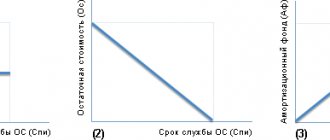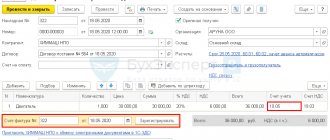Suspension of depreciation
Sometimes depreciation may be suspended. In particular, depreciation is not charged:
- for a period of conservation of a fixed asset lasting more than three months;
- for a period of restoration (reconstruction, repair or modernization) of a fixed asset lasting more than 12 months.
This procedure is provided for in paragraphs 23 and 26 of PBU 6/01.
A complete list of cases in which depreciation is suspended is presented in the table.
Calculation of depreciation in different taxation regimes
Accounting for depreciation of equipment of an LLC or individual entrepreneur depends on the chosen taxation system. Individual entrepreneurs are not required to keep accounting records; therefore, depreciation is accrued only to be taken into account as expenses for tax purposes. Individual entrepreneurs have special features when managing OSNO. The accounting procedure limits the possibility of using only the linear method. For other systems there is no restriction.
When maintaining special regimes, depreciation for accounting purposes is carried out in the general manner. In case of taxation, write-off as expenses is carried out in an accelerated manner.
| Condition | simplified tax system | Unified agricultural tax | UTII |
| Accounting for expenses | Carried out under the object “income minus expenses” | Accepted | Not accepted |
| Decommissioning of equipment with a service life of up to 3 years | During the first year of operation | During the first year of operation | Not taken into account |
| With a service life of 3 to 15 years | 50% in the first year, 30% in the second, 20% in the third | 50% in the first year, 30% in the second, 20% in the third | Not taken into account |
To account for amounts as expenses, the equipment must be paid for and used in the conduct of the business. When paying the supplier for property in several tranches, partial allocation is allowed in proportion to the amount transferred.
Accounting
Depending on the nature of the use of a fixed asset, depreciation accrued on it is included either in expenses for ordinary activities, or in other expenses, or in capital investments. In this case the wiring is carried out:
Debit 20 (23, 25, 44...) Credit 02 – depreciation has been accrued on fixed assets used in the production of goods (performance of work, provision of services) or in trading activities;
Debit 08 Credit 02 – depreciation was accrued on a fixed asset used in the creation (modernization, reconstruction) of another non-current asset;
Debit 91-2 Credit 02 - depreciation has been accrued on a fixed asset used in other types of activities (for example, on a leased fixed asset, if leasing property is not the main activity of the lessor, or on a non-production object).
Such postings must be made monthly (clause 21 of PBU 6/01).
What is depreciable property?
All fixed assets of the enterprise are depreciable. That is, depreciation is charged monthly on the cost of the fixed asset until it is completely written off. Depreciable property is all of the organization's property acquired for profit. Conditions for recognition as an object of fixed assets and depreciable property:
- The property must have a value of over one hundred thousand rubles;
- The period during which the property can be used in economic activity must be more than one year.
If these two conditions are met, the property can be recognized as an object of fixed assets and depreciation can be charged on its value.
Important! Property of mobilization capacities, intellectual property, capital investments and inseparable improvements in the production cycle are also subject to depreciation.
OS is not used in activity
Situation: is it necessary to charge depreciation in accounting for a fixed asset that is registered but is not actually used?
As a general rule, if property is accounted for on account 01 (it is a fixed asset), then regardless of whether it is used in the organization’s activities or not, charge depreciation on it. An exception, in particular, is the conservation of a fixed asset for a period of more than three months and other cases.
The organization may not start using the main tool immediately. In this case, it is accepted for accounting in a separate subaccount to account 01, which may be called, for example, “Fixed assets in stock.” This procedure applies to all fixed assets: movable (acquired, created, requiring installation) and real estate (from the moment of filing documents for state registration of ownership). This follows from subparagraph “a” of paragraph 4 of PBU 6/01, paragraph 20 of the Methodological Instructions approved by Order of the Ministry of Finance of Russia dated October 13, 2003 No. 91n and the Instructions for the Chart of Accounts.
Depreciation in accounting must be calculated starting from the month following the month in which the property was accepted for accounting as a fixed asset (clause 21 of PBU 6/01). Thus, after reflecting the received property on account 01, the organization must begin to depreciate it. This must be done regardless of whether the organization has started using this object or not.
Reflect the amounts of accrued depreciation on account 02 “Depreciation of fixed assets” in correspondence with expense accounts. Select an account for accounting expenses depending on the reason why the fixed asset is not used (production necessity, technological features, planned delay in operation).
Accrue depreciation as part of expenses for ordinary activities (accounts 20, 08, 23, 25, 44...).
For the convenience of generating and tracking information on the amounts of accrued depreciation for fixed assets that are not used in activities, open a separate sub-account for account 02 “Depreciation of fixed assets”. It may be called, for example, “Depreciation of fixed assets in inventory.” In accounting, reflect depreciation on these objects by posting:
Debit 20 (23, 25, 44, ...) Credit 02 subaccount “Depreciation of fixed assets in inventory” - depreciation has been accrued on fixed assets that are not yet used in activities.
At the beginning of actual operation, write off the amount of accrued depreciation:
Debit 02 subaccount “Depreciation of fixed assets in inventory” Credit 02 subaccount “Depreciation of fixed assets in operation” - the amount of previously accrued depreciation was transferred to the subaccount for depreciation of fixed assets in operation.
This procedure is based on the provisions of paragraph 21 of PBU 6/01, paragraphs 9 and 18 of PBU 10/99.
An example of reflecting in accounting depreciation of fixed assets that are not actually used
One of the activities of Alpha LLC is the hotel business. In March, the organization purchased furniture for a room on the fourth floor at one of the hotels. The cost of the headset is 118,000 rubles. (including VAT – 18,000 rubles). The first reservation for the room was received in May.
For accounting and tax purposes, the useful life of the furniture was set at six years (72 months). According to the accounting policy, depreciation on fixed assets is calculated using the straight-line method.
The accountant calculated the annual depreciation rate for furniture as follows: (1: 6 years) × 100% = 17%.
The monthly depreciation amount was: (RUB 118,000 – RUB 18,000) × 17%: 12 months. = 1417 rub.
In the Alpha working chart of accounts, the following subaccounts are approved for account 01 – “Fixed assets in stock”, “Fixed assets in operation”. To account 02 – “Depreciation of fixed assets in operation”, “Depreciation of fixed assets in inventory”.
The accountant made entries in the accounting.
In March:
Debit 08 Credit 60 – 100,000 rub. (RUB 118,000 – RUB 18,000) – the cost of the purchased furniture set is taken into account;
Debit 19 Credit 60 – 18,000 rub. – input VAT is taken into account on the cost of the purchased furniture set;
Debit 01 subaccount “Fixed assets in stock” Credit 08 – 100,000 rub. – the cost of the purchased furniture set is reflected as part of fixed assets;
Debit 68-2 Credit 19-3 – 18,000 rubles. – accepted for deduction of input VAT on purchased furniture.
In April:
Debit 26 Credit 02 subaccount “Depreciation of fixed assets in inventory” – 1417 rubles. – depreciation was accrued on furniture for April.
In May:
Debit 01 subaccount “Fixed assets in operation” Credit 01 subaccount “Fixed assets in stock” – 100,000 rubles. – the furniture set is transferred to the composition of fixed assets actually used;
Debit 02 subaccount “Depreciation of fixed assets in inventory” Credit 02 subaccount “Depreciation of fixed assets in operation” - 1417 rubles. – the amount of previously accrued depreciation was transferred to the subaccount for accounting for depreciation on fixed assets in operation;
Debit 26 Credit 02 subaccount “Depreciation of fixed assets in operation” – 1417 rubles. – depreciation was accrued on furniture for May.
In tax accounting, the accountant also began calculating depreciation in April.
The basic concept of objects subject to depreciation
Depreciable property includes objects that have a useful life of more than twelve months, and their original value is more than forty thousand rubles.
Such property includes:
- Investments of a capital nature that were leased as fixed assets in the form of certain improvements that were carried out with the consent of the lessor by the lessee. They are subject to depreciation in tax accounting.
- Investments made in favor of fixed assets in the form of significant improvements made by the institution that received the loan with the consent of the organization issuing it. Are intangible assets subject to amortization? More on this later.
Depreciable property can be the property of a private entrepreneur or an entire organization that is owned by taxpayers and brings them profit. By analogy with this definition, the question of what is not subject to depreciation can be answered as follows: the taxpayer’s property that does not generate income. In the relevant documents relating to accounting, this definition is disclosed broadly and in detail. In general, we can say that environmental management facilities and land, inventories, unfinished construction projects, goods, financial resources for transactions, as well as securities are not subject to this.
Property that is related to mobilization capacities is certainly subject to depreciation within the established legal order in accordance with Federal Law 206 of November 29, 2012. The following objects are also subject to depreciation:
- property owned by budgetary organizations;
- property created with budget funds;
- property created through targeted cash flows.
It is important to understand that depreciable property, which was received by a unitary enterprise from the owner of another unitary enterprise as part of operational management or economic supervision, is certainly subject to depreciation from the above-mentioned unitary enterprise within the procedure established by law. The same measures also apply to property that was received by an investor organization from the owner of the property, which is dictated in detail in the legal documents of the Russian Federation on agreements in the field of investments related to the scope of activities for the sale of services in the field of public utilities.
People often ask, are fixed assets subject to depreciation? Below we will answer this question.
OS received free of charge
The organization has the right to depreciate fixed assets received free of charge (clause 17 of PBU 6/01). When such objects are received, their market value is taken into account in account 98 “Deferred income”.
As the value of a gratuitously received fixed asset is transferred to expenses, other income is reflected in accounting in an amount equal to the accrued depreciation (clause 29 of the Methodological Instructions, approved by Order of the Ministry of Finance of Russia dated October 13, 2003 No. 91n). In this case, two transactions are performed simultaneously:
Debit 20 (08, 23, 25, 44, 91...) Credit 02 – depreciation has been accrued on a fixed asset received free of charge;
Debit 98 Credit 91-1 - other income is recognized in the amount of depreciation accrued on a fixed asset received free of charge.
Methods and formulas used in accounting
In equipment accounting, several types of depreciation are used. Preference is given to the option that best suits the business conditions of the need for faster write-off of the cost or seasonality of equipment use.
The accounting methods used are:
- Linear, with cost written off in equal parts. The simplest method that does not require additional calculations.
- Reducing balance, in which the residual value of the equipment is taken as the basis. When using this method, it is possible to use a multiplying factor.
- Cumulative, with the amount written off depending on the number of years of operation. The largest amount of write-off occurs in the first years of use. Used for high-tech equipment.
- Production, in which write-off is carried out depending on the volume of products produced. Used for seasonal use of equipment.
| Payment method | Formula | Decoding concepts |
| Linear | Sp x N / 100% | Sp – cost upon registration, N – norm |
| Reducing balance | Co x N x K /100% | Co – residual value, N – norm, K – acceleration coefficient |
| Cumulative | Sp x Cho/Chi | Sp – cost at installation, Cho – number of years until the end of use, Chi – number of years of operation |
| Industrial | Of x Sp / Op | Cn – cost at production, Of – actual release, Op – planned release |
The choice of accrual method must be approved in the local regulations of the enterprise. Organizations using a simplified accounting procedure can charge depreciation once, on the last date of the reporting year.
Depreciation methods
In accounting, depreciation can be calculated:
- in a linear way;
- reducing balance method;
- the method of writing off the cost by the sum of the numbers of years of useful life;
- by writing off the cost in proportion to the volume of products (works).
Fix the chosen method of calculating depreciation in the accounting policy (clause 7 of PBU 1/2008). An organization has the right to apply different methods of calculating depreciation to different groups of homogeneous fixed assets. It is not possible to change the method of calculating depreciation for a specific object after it has been put into operation.
This procedure is provided for in paragraph 18 of PBU 6/01.
If not conservation, then what?
When the product is not planned to be returned to service, there is no point in preserving it. It is more practical to receive a certain income from it and then write it off the balance sheet. This can be done in one of the following ways:
- transfer of unused property for rent (leasing);
- sale of fixed assets.
As a rule, the conditions for these actions are preferential and beneficial for the buyer or lessee. Often the sale of unused real estate occurs through auctions or other organized trading methods.
Used OS
Situation: how to calculate depreciation in accounting for fixed assets that were used by the previous owner?
An organization can charge depreciation on fixed assets that were in use by previous owners, taking into account the period of their operation by the previous owner.
PBU 6/01 does not contain special rules for calculating depreciation for objects that were in operation by previous owners. At the same time, the organization has the right to determine the useful life of this object based on its expected service life. This period can be determined based on an assessment of the technical condition of the object, taking into account its actual wear and tear. Such rules are established by paragraph 20 of PBU 6/01.
For accounting purposes, an organization can determine the useful life of fixed assets according to the Classification approved by Decree of the Government of the Russian Federation of January 1, 2002 No. 1. This document does not give the organization the right to reduce the useful life in comparison with the periods established for a particular depreciation group. In this case, state in the accounting policy that when commissioning fixed assets that were in use by previous owners, their useful life is determined taking into account the period of their operation by the previous owner.
Involving unused property into circulation
The state is especially strict with regard to unused property that is in municipal ownership. Its list is approved by the government, and then involved in economic circulation in accordance with the relevant decree. Main ways of involvement:
- sale at auction, where the starting price will be the base value established by law;
- transfer for free use to individual entrepreneurs or private legal entities;
- transfer for free use;
- other use that does not contradict the law.
Free, but not uncontrolled
The transfer of objects unnecessary to the state to private investors does not happen just like that, but on the basis of a specific investment project. If an entrepreneur is ready to invest money in an unused object (most often this is real estate), this process is strictly regulated and controlled. The investor must prove that this object will actually be given its intended use by providing a project (business plan). If successful, the result will be a mutual benefit:
- instead of empty buildings and structures, useful functioning objects will appear;
- new jobs will be in demand for them, which will bring income to both the entrepreneur and the budget;
- If all conditions are met, the object then becomes the property of the investor who invested in it.
Sale by auction
Auctions for unused property as a means of involving it in circulation are most often used.
Everything is clear with items and equipment - they simply become the property of a new owner who plans to use them. If real estate is sold, then the land plot on which it is located is most often given for rent. The auction is announced in advance in the media, on specialized platforms and publications, applications for participation are submitted, and the auction is held among applicants.
If no one has purchased the lot, the following measures may be taken:
- the cost is reduced by 20%;
- after the second unsuccessful trades – by another 50%;
- maximum reduction – up to 80% of the initial price.
The new owner must deposit the money within the prescribed period, otherwise the results of the auction will be canceled.





